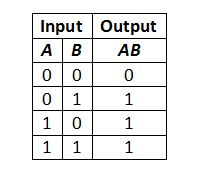Digital systems are all around us. We use them on a daily basis, sometimes not realizing we’re using one. It’s not an understatement to say that, perhaps, a world without digital systems would be nothing short of a dystopia.
Without logic gates, however, there wouldn’t be any digital systems. Digital logic gates are the building blocks of every digital system. In the simplest terms possible, a digital logic gate is an electronic circuit which has single or multiple inputs and only one output.
The name, logic gate, comes from the fact that the relationship between the input and output is based on logic. Based on this logic, these gates are classified as AND, OR, NOT, etc. The inputs and outputs both are in linear form.
The primary implementation of logic gates is carried out through diodes and transistors, which function as electronic switches. Nevertheless, logic gates can also be, and have been, implemented using vacuum tubes, relays, optics, fluidic or pneumatic logic, molecules and even mechanical elements!
Some of the most common circuits based on logic gates are multiplexers, ALUs (Arithmetic Logic Units), registers, memory devices for computers, and microprocessors as well! In fact, a microprocessor has over 100 million logic gates!

Types of Digital Logic Gates
As mentioned before, there are many different types of logic gates. However, there are only three basic types: AND, OR, and NOT. These three gates are used in combination as well to create compound gates such as the NOR Gate, the NAND Gate, and the Buffer.
These individual gates are further connected together to create complex circuits known as Combinational Logic Circuits. Before we talk about the more complex gates, let’s discuss the three basic ones.
AND Gate
AND Gate and OR Gate are based on the principle of conjunction and disjunction. For instance, in an AND Gate, unless both the inputs are ones, the output will always be zero. Take a look at the truth table for the AND Gate to get a better understanding of its function.

OR Gate
As discussed before, the OR Gate is a circuit which is based on the principle of mathematical disjunction, i.e. if even one of the inputs is positive or a one, the output will be one.

NOT Gate
Also known as the inverter, the NOT Gate always has one input and one output. As the name suggests, the inverter circuit gives an output which is essentially the reversed input.

ADSANTEC’s High-Speed Logic Family
There’s no denying the significance of logic gates in our digital age. It’s the building block of every digital device. If you’re looking for circuits based on logic gates, ADSANTEC houses a vast collection of logic circuits.
Check out the online store to get limiting amplifiers, digital signal splitters, Boolean logic gates, and D-type flip-flops or get in touch now!